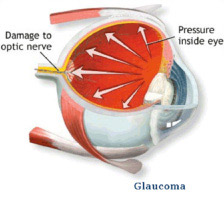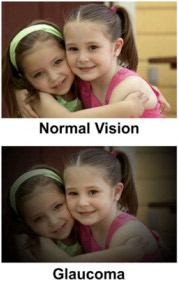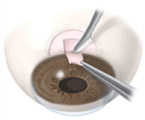The Basics of Glaucoma
 What is glaucoma?
What is glaucoma?
Glaucoma is a group of disorders in which the eye pressure is too great for the health of the optic nerve. It is estimated that over 4 million Americans have glaucoma but only half of those know they have it. Glaucoma is a leading cause of irreversible blindness in the United States, and often has no symptoms. The optic nerve is the part of the eye that sends signals to the brain, allowing me to see. If the optic nerve is damaged by untreated glaucoma, this may lead to slow, painless, permanent loss of vision. However, with early diagnosis and treatment, blindness is not inevitable. There are some groups of people who may be at increased risk of glaucoma. If you have a family member with glaucoma, there is an increased risk that you will also have glaucoma. African-Americans are 6 to 8 times more likely than whites to develop glaucoma, and much more likely to go blind from the disease. There are 2 main types of glaucoma: open-angle and closed-angle glaucoma.
Open angle glaucoma is one of the many forms of glaucoma, and makes up about 90% of glaucoma in the United States. In open-angle glaucoma, the "drain" of the eye, formed by the iris and the cornea, is not functioning properly, which causes the fluid in the front of the eye (aqueous humor) to build up, and causes elevated eye pressure. This condition may be associated with "high" eye pressures, however I now know that there is a subgroup of individuals who have "normal-pressure" or "low-pressure" glaucoma, with pressures in the normal range of 10-22. The pressure in the eye can vary quite a bit, so several office visits may be required to get an idea of the "trend" of a person's true eye pressure.
Closed-angle glaucoma is seen in patients with narrow angles, and causes the eye pressure to rise rapidly. This causes pain and blurred vision and requires laser treatment, called an iridotomy.
 Although there is no "cure" for glaucoma, treatment can be highly effective and may prevent individuals from losing any vision. People who benefit from routine glaucoma screening are those at "high-risk", including people with:
Although there is no "cure" for glaucoma, treatment can be highly effective and may prevent individuals from losing any vision. People who benefit from routine glaucoma screening are those at "high-risk", including people with:
- African ancestry
- Family history of glaucoma
- Diabetes
- Hypertension
- Near-sightedness (myopia)
- Chronic corticosteroid use
- History of serious eye injury
How is glaucoma diagnosed?
Early diagnosis is imperative to saving vision. To diagnose glaucoma, the ophthalmologist will do several tests during a routine eye exam. First, the eye pressure is checked. Second, the drainage angle is examined using a special lens on your eye; this is done to determine the type of glaucoma. Next, the optic nerves are examined. If the ophthalmologist suspects glaucoma, you will then be asked to do a peripheral visual field, and take pictures of the optic nerves for long-term follow-up.
Can glaucoma be treated?
Yes.
 What are the ways to treat glaucoma?
What are the ways to treat glaucoma?
Treatment is instituted as soon as glaucoma is diagnosed. The options to treat glaucoma include medicine, laser and surgery. Medicines (eye drops and pills) have been used since the 1870's to lower eye pressure, and thus reduce the risk of vision loss. Eye drops are the most common form of initial treatment for open-angle glaucoma. The medicines used to treat glaucoma are tailored to the individual patient and must take into account the cost, effectiveness, and possible side-effects. There are several families of eye drops currently available, and these either act to reduce the production of aqueous humor, or improve the outflow of the drain, or both. Most eye drops may sting or burn when placed on the eye. This does not mean that they are not working, or that they are causing harm. Some people may find a specific eye drop more comfortable than others. Research is ongoing to determine if some available medications may also have protective properties in addition to their pressure-lowering effects.
If patients do not respond to medicines, or develop side effects, laser or conventional glaucoma surgery can be performed. Laser for open-angle glaucoma is called selective laser trabeculoplasty (SLT), where light energy is focused on the drainage system of the eye to allow the drain to work more efficiently. It works in about 75-80% of individuals to lower the eye pressure and possibly reduce the amount of medications used; the effect may be short-lived, however, therefore you will still require close follow-up with your eye care provider. The effect wears off in about 50% of patients at 5 years. This procedure is usually painless can be done in the ophthalmologist's office: drops are given to numb the eye, a lens is placed on the eye to help focus the laser beam, and a short course of anti-inflammatory medications are often prescribed for several days following the procedure. The procedure is usually done one eye at a time, but is usually required in both. The laser can be repeated with similar result if people have had previous pressure-lowering effect. The laser for closed-angle glaucoma is an iridotomy, where a small hole is made in the iris of the eye, to prevent or cure an "attack" of glaucoma in people with narrow drainage angles.
Surgery for glaucoma is an option when medications and laser cannot lower the pressure enough. It is done as an outpatient surgery with local anesthesia, and involves creating a new filter in the eye to drain the fluid and lower the pressure. The most common procedure is a trabeculectomy, which is when the surgeon makes a flap in the white of the eye, allowing fluid to flow out through that flap and creating a "bleb" or blister on the surface of the eye. Tiny stitches are used to close the wound, and may be removed after surgery to increase the function of the drain. This procedure can adequately control eye pressure in 3 out of 4 patients. Close follow-up with the surgeon is needed after surgery to make sure the new drain is functioning properly, however many people will no longer need to use eye drops after surgery.
Depending on the type and severity of glaucoma, and how much pressure-lowering is required, other treatment procedures are available. Aqueous shunt, or "tube" surgery is usually recommended in certain types of glaucoma with a lot of associated inflammation, such as uveitis or neovascular glaucoma. A shunt drains excess fluid from a tiny tube inside the eye which is attached to a small reservoir on the eye. Another option for pressure lowering is cyclophotocoagulation, which is a laser used to reduce the amount of fluid produced in the eye. This is generally used to treat very advanced or aggressive glaucoma, and is used after other treatments have been unsuccessful.
How can I find out more information about glaucoma?
Internet resources for glaucoma:
www.glaucoma.org
www.glaucomafoundation.org
www.webmd.com/eye-health/tc/glaucoma-topic-overview
Back to top